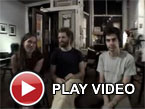 Adem Ilhan, best known for his bass work in Fridge, showcases hisprominent talents as a solo singer, songwriter, instrumentalist,arranger and producer on this four-song EP, recorded in what he refersto as his werehome. The lush instrumentation and warm progressions onthe rootsy ballad "These Are Your Friends" highlights Ilhan's acousticguitar work, tender vocals and emotional lyrics such as "You've thrownyourself/Into the flames 'cause you're covered in cold." In context,they can bring a tear to the eye. The acoustic strumming of "After theStorm" accompanies a delicate vocal melody which provides the narrativeof a father's loss of his son to the sea, nicely filled out with banjoand a hummed chorus. Musically, the eerie "Let It Burn" focuses on thearpeggiated chord progressions of a kalimba, augmented by Ilhem's ebband flow vocals which at times are doubled-up with xylophone. This EPis a very rich and pleasant surprise from what I would have expectedfrom a member of Fridge, knowing the more electronic direction thatbandmate Kieran Hebden has gone as FourTet. With his full-length Homesongsdisc out, a four-piece touring band and a great video (which can befound on the Domino website) it won't come as a surprise to be seeing alot more of Adem this year.
Adem Ilhan, best known for his bass work in Fridge, showcases hisprominent talents as a solo singer, songwriter, instrumentalist,arranger and producer on this four-song EP, recorded in what he refersto as his werehome. The lush instrumentation and warm progressions onthe rootsy ballad "These Are Your Friends" highlights Ilhan's acousticguitar work, tender vocals and emotional lyrics such as "You've thrownyourself/Into the flames 'cause you're covered in cold." In context,they can bring a tear to the eye. The acoustic strumming of "After theStorm" accompanies a delicate vocal melody which provides the narrativeof a father's loss of his son to the sea, nicely filled out with banjoand a hummed chorus. Musically, the eerie "Let It Burn" focuses on thearpeggiated chord progressions of a kalimba, augmented by Ilhem's ebband flow vocals which at times are doubled-up with xylophone. This EPis a very rich and pleasant surprise from what I would have expectedfrom a member of Fridge, knowing the more electronic direction thatbandmate Kieran Hebden has gone as FourTet. With his full-length Homesongsdisc out, a four-piece touring band and a great video (which can befound on the Domino website) it won't come as a surprise to be seeing alot more of Adem this year.samples:



 It has been a few years since this German trio, comprised of brothers Ronald and Robert Lippok and Stefan Schneider, released their Kölner Brett and Pantone EPs, although members have been busy with other notable projects such as Tarwater and Mapstation. For the better part of their latest disc, Hotel Morgen, they appear to have fallen back on their unique compositional style and structures, use of instrumental and electronic-based sounds and space, which has made them one of my favorite groups, but without the type of sit-up-and-take-notice advances I expected after such a hiatus.
It has been a few years since this German trio, comprised of brothers Ronald and Robert Lippok and Stefan Schneider, released their Kölner Brett and Pantone EPs, although members have been busy with other notable projects such as Tarwater and Mapstation. For the better part of their latest disc, Hotel Morgen, they appear to have fallen back on their unique compositional style and structures, use of instrumental and electronic-based sounds and space, which has made them one of my favorite groups, but without the type of sit-up-and-take-notice advances I expected after such a hiatus.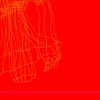 Listening to German-based Margareth Kammerer is almost as difficult as attempting to read German without some kind of pocket dictionary. Her style is pale and remote, her attitude near the border of nonexistent, and her references obscure. It's to my benefit that B. Fleischmann, Philip Jeck, and Chris Abrahams are all over this record because, as interesting as her poetic deliveries can be, the semi-charming resonance that marks this recording simply wasn't doing it for me by itself.
Listening to German-based Margareth Kammerer is almost as difficult as attempting to read German without some kind of pocket dictionary. Her style is pale and remote, her attitude near the border of nonexistent, and her references obscure. It's to my benefit that B. Fleischmann, Philip Jeck, and Chris Abrahams are all over this record because, as interesting as her poetic deliveries can be, the semi-charming resonance that marks this recording simply wasn't doing it for me by itself.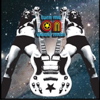 A critical theory professor (whose classes I do not miss at all) onceripped me a new one for making light of The Self-Positioning Statement,that warning sign of gutless scholarly writing that lets all of yourreaders know what a horrible sexist oppressor you are before theyexpose themselves to your thoughts. 'Cause, you know, those same wordswould have a -totally- different effect on their readers if they werecoming from a Trobriand Islander. This is my indirect way of 'fessingup to the fact that I paid very little attention to the capital-Aalternative rock scene in the mid-to-late-'90s, and that I won't beable to tell you exactly which Jane's Addiction album God Bless the Electric Freaksounds a lot like; indeed, it's even a way of saying that I've neverheard a Jane's Addiction album, and that the comparison only came to mevia press blurbs on the band's web site. Taken together, all of thismight even say that, if you got sick of bands with fuzzy guitars in themid-to-late-'90s, you might be inclined to give this one a miss. You'dbe passing up on an entertainingly mixed bag of ideas, though:"Sunshine Supercreep" weaves effected sitar highlights through guitarlines that would have been entirely at home on whichever local radiostation was called The Edge in 1996, and tosses in some vocal harmoniesand UFO-addled lyrics to weird things up a bit, only to give way towhat could easily be My Life with the Thrill Kill Kult trying to hackit as a Metallica tribute band on "Apocalypse Rock" four minutes later.There are a couple of clunkers along the way ("Astrophobia" is draggeddown by its stupid space-hippie lyrics, and the dull pair ofinstrumental interludes really just have me reaching for thetrack-forward button about 30 seconds into each one), but the generallyhigh standard of production, combined with a feeling that the peopleinvolved actually took the time to write and refine their musicalideas, elevate God Bless the Electric Freak well beyond thespace-rock silliness that it could otherwise have been. It's notacademically rigorous by any means, but it sounds like the output ofthe people who were actually worth knowing when you were at university,which is a better deal for my seven bucks.
A critical theory professor (whose classes I do not miss at all) onceripped me a new one for making light of The Self-Positioning Statement,that warning sign of gutless scholarly writing that lets all of yourreaders know what a horrible sexist oppressor you are before theyexpose themselves to your thoughts. 'Cause, you know, those same wordswould have a -totally- different effect on their readers if they werecoming from a Trobriand Islander. This is my indirect way of 'fessingup to the fact that I paid very little attention to the capital-Aalternative rock scene in the mid-to-late-'90s, and that I won't beable to tell you exactly which Jane's Addiction album God Bless the Electric Freaksounds a lot like; indeed, it's even a way of saying that I've neverheard a Jane's Addiction album, and that the comparison only came to mevia press blurbs on the band's web site. Taken together, all of thismight even say that, if you got sick of bands with fuzzy guitars in themid-to-late-'90s, you might be inclined to give this one a miss. You'dbe passing up on an entertainingly mixed bag of ideas, though:"Sunshine Supercreep" weaves effected sitar highlights through guitarlines that would have been entirely at home on whichever local radiostation was called The Edge in 1996, and tosses in some vocal harmoniesand UFO-addled lyrics to weird things up a bit, only to give way towhat could easily be My Life with the Thrill Kill Kult trying to hackit as a Metallica tribute band on "Apocalypse Rock" four minutes later.There are a couple of clunkers along the way ("Astrophobia" is draggeddown by its stupid space-hippie lyrics, and the dull pair ofinstrumental interludes really just have me reaching for thetrack-forward button about 30 seconds into each one), but the generallyhigh standard of production, combined with a feeling that the peopleinvolved actually took the time to write and refine their musicalideas, elevate God Bless the Electric Freak well beyond thespace-rock silliness that it could otherwise have been. It's notacademically rigorous by any means, but it sounds like the output ofthe people who were actually worth knowing when you were at university,which is a better deal for my seven bucks.  The instrumental hip-hop crowd is already sloughing off towardsinsignificance, with recent releases showing little to no innovation onthe original themes. Another can be added to that list with this latestfrom RJD2, whose new sounds definitely come from the same old tricksfor this set. Truth be told, his last full-length did nothing for me,but the remixes on the HorrorEP gave me some hope that he'd pulled himself out from under theshadows of others to create something original; maybe he learned alesson in that if he let things cook a bit more there'd be somethingreal. That hope not only disappeared but was mercilessly crushed on theopening track, where the same stale drum samples are accompanied byfast cut fades and piano plunks. Then a slow fade out that sounds likeit could be the end of the track, which would have been fine by me, asit seemed like an intro at best. Suddenly, though, the track comesright back in at full volume — SURPRISE! — and right back into the samelame line with a few distorted additions, before fading out slow again,only to come right back in in the same fashion. (It's not the beststart.) RJD2 has a genuine talent for pulling out good voices to throwin on his records, it's just what he layers them over that lacks hereand there and sometimes everywhere. "Exotic Talk" uses a vocoder over amore rock sound, but its bombast is forced and synthetic in nature, notactual. The songs here use vastly varied samples, but the compositionis so very much the same that it never succeeds in revealing anythingmore than the last record. Why he bothered to explore new areas interms of genres to sample, but stayed with the same old productiontechniques, is beyond me. Awkward missteps, like the vocal on "MakingDays Longer," don't improve the overall package, but instead bring itdown even further. There are moments where everything is not mired inmediocrity, such as "Someone's Second Kiss," with its soul vocals andkeyboard soliloquy. Next time, though, it would be beneficial if RJD2expanded his whole repertoire instead of some semblance of it, as itmight create the genre-busting album this genre desperately needs. Plus, an open note to Definitive Jux: Please stop sending out promotional copies of releases that contain anti-pirating voice stamps. It makes it impossiblefor any writer to get a good idea of the music when a voice remindsthem that it's a promo every thirty seconds. At least send out cleancopies to press sources or street teams. I wouldn't have reviewed therecord if I hadn't bought it myself, as it's that detrimental to thelistening experience. Just a thought. I'd never heard anything like itbefore I received this CD.
The instrumental hip-hop crowd is already sloughing off towardsinsignificance, with recent releases showing little to no innovation onthe original themes. Another can be added to that list with this latestfrom RJD2, whose new sounds definitely come from the same old tricksfor this set. Truth be told, his last full-length did nothing for me,but the remixes on the HorrorEP gave me some hope that he'd pulled himself out from under theshadows of others to create something original; maybe he learned alesson in that if he let things cook a bit more there'd be somethingreal. That hope not only disappeared but was mercilessly crushed on theopening track, where the same stale drum samples are accompanied byfast cut fades and piano plunks. Then a slow fade out that sounds likeit could be the end of the track, which would have been fine by me, asit seemed like an intro at best. Suddenly, though, the track comesright back in at full volume — SURPRISE! — and right back into the samelame line with a few distorted additions, before fading out slow again,only to come right back in in the same fashion. (It's not the beststart.) RJD2 has a genuine talent for pulling out good voices to throwin on his records, it's just what he layers them over that lacks hereand there and sometimes everywhere. "Exotic Talk" uses a vocoder over amore rock sound, but its bombast is forced and synthetic in nature, notactual. The songs here use vastly varied samples, but the compositionis so very much the same that it never succeeds in revealing anythingmore than the last record. Why he bothered to explore new areas interms of genres to sample, but stayed with the same old productiontechniques, is beyond me. Awkward missteps, like the vocal on "MakingDays Longer," don't improve the overall package, but instead bring itdown even further. There are moments where everything is not mired inmediocrity, such as "Someone's Second Kiss," with its soul vocals andkeyboard soliloquy. Next time, though, it would be beneficial if RJD2expanded his whole repertoire instead of some semblance of it, as itmight create the genre-busting album this genre desperately needs. Plus, an open note to Definitive Jux: Please stop sending out promotional copies of releases that contain anti-pirating voice stamps. It makes it impossiblefor any writer to get a good idea of the music when a voice remindsthem that it's a promo every thirty seconds. At least send out cleancopies to press sources or street teams. I wouldn't have reviewed therecord if I hadn't bought it myself, as it's that detrimental to thelistening experience. Just a thought. I'd never heard anything like itbefore I received this CD. 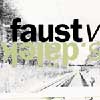 On paper, the pairing of German krautrock godfathers Faust with NewJersey Hip Hop trio Dälek sounds like a soundclash of epic porportionsthat has as much potential to work as it does to fail spectacularly.Through a brief studio collaboration while Dälek were on tour inEurope, the unlikely became a reality and the result is the eight-trackalbum Derbe Respect, Alder.The mutual respect and admiration from both sides is on full displayhere, as Dälek let Faust jam sloppily over pieces of tracks that wouldbe much tighter on a Dälek record proper. Meanwhile, Faust step backand react, allowing Dälek to infuse the tracks with their signaturetake on abrasive hip hop. Dälek (The MC) flows in an open verse styleover cavernous drones and the sounds of giants battling. Looped beatsmake an appearance and then give way to uncompromising live drummingand bass that takes the funk and mechanizes, becoming less of aninvitation to dance and more of a directive. To their credit, all ofthe performers try to make it work and take what could have been aconfluence of meandering noise and shape it into loose, jammy songs.That none of this is scripted or pre-planed is obvious from the start.In fact, the recording often sounds like a straight mix of a livesession even though parts and takes have been reconstructed somewhatafter the fact. Lo-Fi is the aesthetic of choice rendering the soundquality and mix frustrtating at times. Though these are finished albumtracks, some of the songs are so raw that they more closely resembledemos. This is the sound of two sets of performers learning from eachother and making some noise in the process that is both dense andmacabre, but not entirely unexepected given the creators' respectivebackcatalogs. I find myself appreciating the record more than likingit; I understand the journey and the purpose of it all but it's notalways a trip that I want to take. A straight-up Faust or Dälek recordwould probably find heavier rotation in my player, but being aspectator through Derber Respect, Alder certainly has itsrewards. There's a certain amount of faith required for a project likethis to work, and it calls on listeners to meet the record halfway, toaccept the technical shortcomings and take them with the music as areflection of the experience of creation. The final result is a tenuousbridge between drastically different styles and methodologies thatdemonstrates the power of abandoning preconceptions and going where thecloudy haze of inspiration takes you.
On paper, the pairing of German krautrock godfathers Faust with NewJersey Hip Hop trio Dälek sounds like a soundclash of epic porportionsthat has as much potential to work as it does to fail spectacularly.Through a brief studio collaboration while Dälek were on tour inEurope, the unlikely became a reality and the result is the eight-trackalbum Derbe Respect, Alder.The mutual respect and admiration from both sides is on full displayhere, as Dälek let Faust jam sloppily over pieces of tracks that wouldbe much tighter on a Dälek record proper. Meanwhile, Faust step backand react, allowing Dälek to infuse the tracks with their signaturetake on abrasive hip hop. Dälek (The MC) flows in an open verse styleover cavernous drones and the sounds of giants battling. Looped beatsmake an appearance and then give way to uncompromising live drummingand bass that takes the funk and mechanizes, becoming less of aninvitation to dance and more of a directive. To their credit, all ofthe performers try to make it work and take what could have been aconfluence of meandering noise and shape it into loose, jammy songs.That none of this is scripted or pre-planed is obvious from the start.In fact, the recording often sounds like a straight mix of a livesession even though parts and takes have been reconstructed somewhatafter the fact. Lo-Fi is the aesthetic of choice rendering the soundquality and mix frustrtating at times. Though these are finished albumtracks, some of the songs are so raw that they more closely resembledemos. This is the sound of two sets of performers learning from eachother and making some noise in the process that is both dense andmacabre, but not entirely unexepected given the creators' respectivebackcatalogs. I find myself appreciating the record more than likingit; I understand the journey and the purpose of it all but it's notalways a trip that I want to take. A straight-up Faust or Dälek recordwould probably find heavier rotation in my player, but being aspectator through Derber Respect, Alder certainly has itsrewards. There's a certain amount of faith required for a project likethis to work, and it calls on listeners to meet the record halfway, toaccept the technical shortcomings and take them with the music as areflection of the experience of creation. The final result is a tenuousbridge between drastically different styles and methodologies thatdemonstrates the power of abandoning preconceptions and going where thecloudy haze of inspiration takes you. The second in the two labels' collaborative series of collaborative works, Reciprocess 02features duo, solo, and reciprocal remix tracks by Stephen Mathieu'sFull Swing and Douglas Benford's Si-cut.db. The series' goal is easyenough: to explore the "process" of collaboration in a morecomprehensive way by including evidence of the artists alone, together,and at conscious remove from each other. The most interesting thingabout this set-up is the way it questions the assumed ideal of anycollaboration. By anticipating the range of synthesis and clashavailable to any two artists, Reciprocess assures that thedecision of "which combination is better?" becomes both well-informedand harder to make. Sometimes the points of divergence within aparticular union can be the most interesting, as was the case withvolume one, Komet +/vs. Bovine Life. Conversely on 02,Mathieu and Benford transcend even "complimentary" status by focusingtheir contributions into such a sleek, consistent product thatdistinguishing between remix, joint effort, and solo work will no doubtrequire a second look at the liner notes. Those already familiar withFull Swing will find Mathieu's two solo tracks echo much of theclick-less, bass-driven dub Benford has perfected throughout his yearsunder the Si-cut.db name. His simple and immediate melodic approach,something Mathieu's idiosyncratic output has often rejected, becomesthe disc's support, a skeleton filled in by Full Swing's vibrantglitch-ist accompaniment. Mathieu is one artist whose reliance onglitch or microsound method never seems to result in the same tireddeconstructionist route; he can atomize sound with the best of them buthis reformations always reach further than the simple end of exploitingmusic's ephemeral qualities. Being forced to accommodate Benford'ssolid, even danceable structures only further enlivens hiscollaborator's technique, encouraging dense, swooning textures thatwill inevitably recall the work of Christian Fennesz. In fact, Reciprocess 02would not be a bad recommendation for anyone curious about the resultof a collaboration between the Viennese artist and, say, someone fromthe ~scape label. As with anything Mathieu has a hand in, though, it isspecial on its own terms, fusing the distinctly modern elegance anddelicacy of his music with Benford's more extroverted and romanticstyle in ways that reveal each must have had some affection for theother all along.
The second in the two labels' collaborative series of collaborative works, Reciprocess 02features duo, solo, and reciprocal remix tracks by Stephen Mathieu'sFull Swing and Douglas Benford's Si-cut.db. The series' goal is easyenough: to explore the "process" of collaboration in a morecomprehensive way by including evidence of the artists alone, together,and at conscious remove from each other. The most interesting thingabout this set-up is the way it questions the assumed ideal of anycollaboration. By anticipating the range of synthesis and clashavailable to any two artists, Reciprocess assures that thedecision of "which combination is better?" becomes both well-informedand harder to make. Sometimes the points of divergence within aparticular union can be the most interesting, as was the case withvolume one, Komet +/vs. Bovine Life. Conversely on 02,Mathieu and Benford transcend even "complimentary" status by focusingtheir contributions into such a sleek, consistent product thatdistinguishing between remix, joint effort, and solo work will no doubtrequire a second look at the liner notes. Those already familiar withFull Swing will find Mathieu's two solo tracks echo much of theclick-less, bass-driven dub Benford has perfected throughout his yearsunder the Si-cut.db name. His simple and immediate melodic approach,something Mathieu's idiosyncratic output has often rejected, becomesthe disc's support, a skeleton filled in by Full Swing's vibrantglitch-ist accompaniment. Mathieu is one artist whose reliance onglitch or microsound method never seems to result in the same tireddeconstructionist route; he can atomize sound with the best of them buthis reformations always reach further than the simple end of exploitingmusic's ephemeral qualities. Being forced to accommodate Benford'ssolid, even danceable structures only further enlivens hiscollaborator's technique, encouraging dense, swooning textures thatwill inevitably recall the work of Christian Fennesz. In fact, Reciprocess 02would not be a bad recommendation for anyone curious about the resultof a collaboration between the Viennese artist and, say, someone fromthe ~scape label. As with anything Mathieu has a hand in, though, it isspecial on its own terms, fusing the distinctly modern elegance anddelicacy of his music with Benford's more extroverted and romanticstyle in ways that reveal each must have had some affection for theother all along. 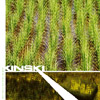 For those who are familiar only with the most easily available recordedworks of Kinski (ie: the Sub Pop releases), this album might besomewhat of a mystery: it's not the blistering loud rock sounds feltmiles away, but a collection of the gentle, spacey tunes Kinski liveaudiences have paid witness to for years. The disc opens with the briefechoed guitar work of "Never Compete with Small Girls," then isfollowed by a nearly half hour live performance, "The Misprint in theGutenberg Print Shop," recorded live in Seattle. This tune, along withthe rest of the disc pretty much, is a real trip, with twitteringprimitive effects and chiming sounds, rumbling echoed bass, and aserene flute on top. It's ghostly and intoxicating, moves through anumber of different phases, from swelling sounds to parts so quiet apin could be heard dropping, and it never gets stale or dull. I'm notsurprised the group has toured extensively with Acid Mothers Temple,but unlike AMT, Kinski has never bored me or made me long for a songending. There's not much room left on the disc after the massive trackbut three tracks under five minutes complete the collection. "Crepesthe Cheap" continues with drumless bliss like a spaceship in a cheapsci-fi film taking off, while "Bulky Knit Cheerleader Sweater" is awafting wall of guitars as dense as the title, and the closer, "There'sNothing Sexy About Time" drones off into the distance. While Don't Climbisn't representative of Kinski's entire range of sound, it does providea good companion piece to the more rockin bits and can certainlyprovide a good "coming down" album when leaving a concert from thefoursome that has left ears bleeding in the path.
For those who are familiar only with the most easily available recordedworks of Kinski (ie: the Sub Pop releases), this album might besomewhat of a mystery: it's not the blistering loud rock sounds feltmiles away, but a collection of the gentle, spacey tunes Kinski liveaudiences have paid witness to for years. The disc opens with the briefechoed guitar work of "Never Compete with Small Girls," then isfollowed by a nearly half hour live performance, "The Misprint in theGutenberg Print Shop," recorded live in Seattle. This tune, along withthe rest of the disc pretty much, is a real trip, with twitteringprimitive effects and chiming sounds, rumbling echoed bass, and aserene flute on top. It's ghostly and intoxicating, moves through anumber of different phases, from swelling sounds to parts so quiet apin could be heard dropping, and it never gets stale or dull. I'm notsurprised the group has toured extensively with Acid Mothers Temple,but unlike AMT, Kinski has never bored me or made me long for a songending. There's not much room left on the disc after the massive trackbut three tracks under five minutes complete the collection. "Crepesthe Cheap" continues with drumless bliss like a spaceship in a cheapsci-fi film taking off, while "Bulky Knit Cheerleader Sweater" is awafting wall of guitars as dense as the title, and the closer, "There'sNothing Sexy About Time" drones off into the distance. While Don't Climbisn't representative of Kinski's entire range of sound, it does providea good companion piece to the more rockin bits and can certainlyprovide a good "coming down" album when leaving a concert from thefoursome that has left ears bleeding in the path. 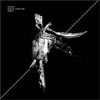 Digital Lifeforms marks the point where Richard H. Kirk, formerly a dour, paranoid composer, released a happy, intelligent, danceable album. Originally released on Touch in 1993, the disc consists of ten distinct, separate, non-experimental tracks, all upbeat and surprisingly commercial (although without sounding naive, obvious or shit). For those who weren't able to get the original copy twelve years ago, this expanded version is now available.
Digital Lifeforms marks the point where Richard H. Kirk, formerly a dour, paranoid composer, released a happy, intelligent, danceable album. Originally released on Touch in 1993, the disc consists of ten distinct, separate, non-experimental tracks, all upbeat and surprisingly commercial (although without sounding naive, obvious or shit). For those who weren't able to get the original copy twelve years ago, this expanded version is now available.